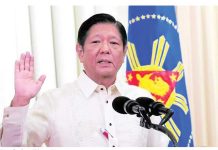
THE ECONOMY is showing signs of life in the early phase of its reopening. It is an encouraging sign that health authorities should appreciate while the Philippines continues its battle against the COVID-19 pandemic.
I believe that with the government adopting a surgical approach to contain the coronavirus pandemic, now is the time to allow more industries to reopen under the more relaxed modified general community quarantine (MGCQ) in Metro Manila and nearby provinces.
I fully agree with Finance Secretary Carlos Dominguez III. Putting Metro Manila and the Calabarzon (Cavite, Laguna, Batangas, Rizal and Quezon) corridor under the more moderate MGCQ will accelerate economic recovery “as quickly as possible.”
Secretary Dominguez is being pragmatic about the pandemic. The reality is that the virus will not go away. The country, he says, will have to live with it for a longer period, but “we really should begin opening,” citing that Metro Manila and Calabarzon account for about 67 percent of the country’s gross domestic product.
The economy is now throbbing compared with the early stages of the lockdown. A survey by London-based research firm IHS Markit shows the Philippines’ purchasing manager’s index, which represents factory production, improved to 49.7 in June from 40.1 in May. This is the highest PMI since February this year and signals a movement toward stabilization of the manufacturing sector.
IHS Markit economist David Owen credited the improved PMI to the government’s decision to shift from the enhanced community quarantine to the GCQ in June, allowing factories to resume operations, albeit at a limited capacity. A shift to MGCQ is expected to further boost manufacturing capacity utilization rates.
Another encouraging sign is the 28-percent increase in revenue collections in June, following a 49-percent nosedive in May, after authorities allowed more government offices to reopen.
Combined collections of the Bureau of Internal Revenue and Bureau of Customs reached P211.50 billion in June, up by P59.28 billion or 28 percent from the same month last year, according to Department of Finance data.
The June figures brought total collections in the first half to P1.155 trillion, although they are still down by P220.47 billion or 16 percent from P1.375 trillion a year ago. The DOF noted that the “unprecedented coronavirus pandemic continued to pummel the economy and restrict business activity in most parts of the country.”
Economists from First Metro Investment Corp. and University of Asia & the Pacific also noted similar favorable economic indicators, such as the increase in government spending, stable inflation rate and strong peso. They recommended further easing of quarantine restrictions, such as allowing more employees to return to work and authorizing more public utility vehicles to operate. (To be continued/PN)





